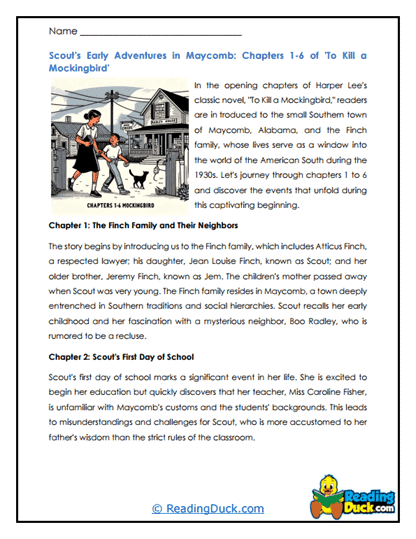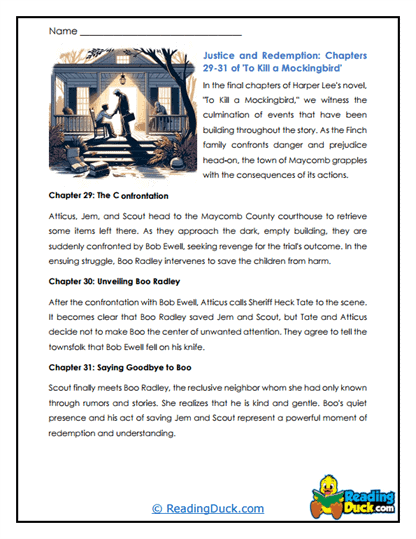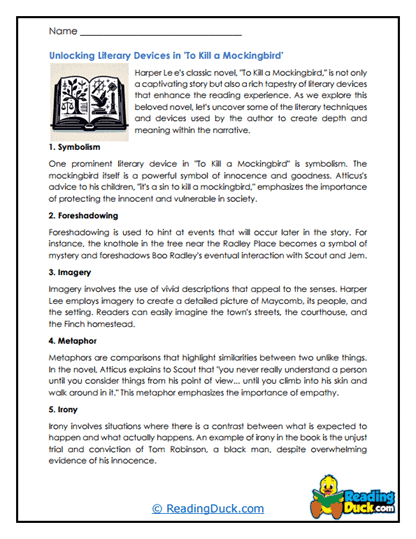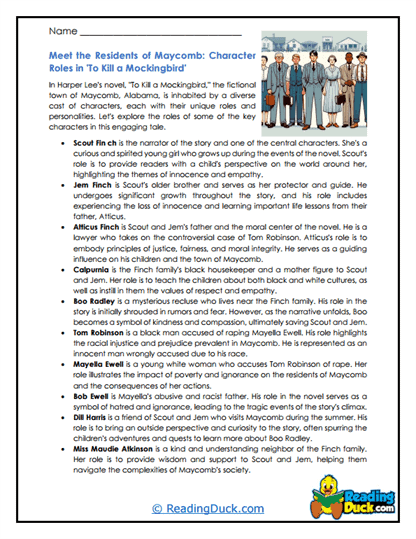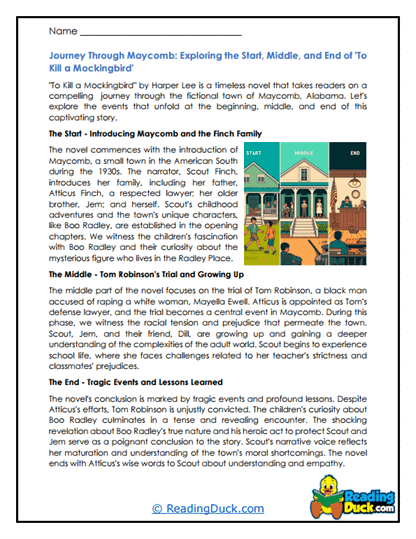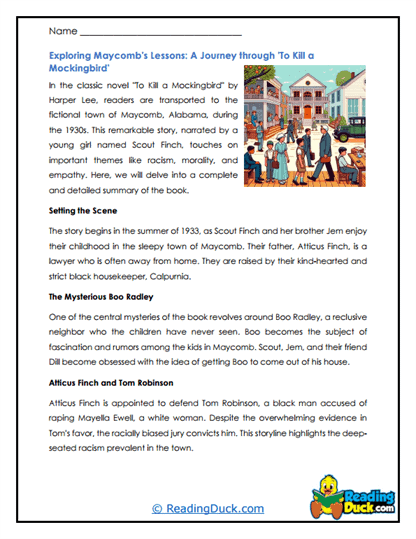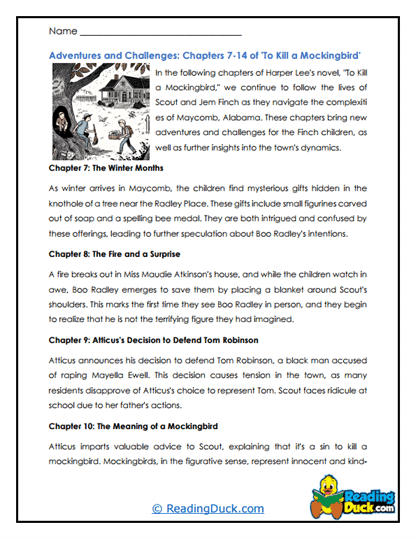To Kill a Mockingbird Worksheets
About Our To Kill a Mockingbird Worksheets
Our To Kill a Mockingbird worksheets offer a comprehensive and engaging exploration of Harper Lee’s iconic novel, guiding students through its profound themes, memorable characters, and powerful social commentary. These worksheets are designed to foster critical thinking, enhance literary analysis, and help students connect personally with the text, making them an invaluable resource for any literature curriculum.
The Literature category that includes To Kill a Mockingbird also covers a range of other notable and classical works, such as 1984, Fahrenheit 451, Lord of the Flies, Of Mice and Men, Pride and Prejudice, Romeo and Juliet, The Diary of Anne Frank, The Great Gatsby, and The Scarlet Letter. Each collection is carefully organized to provide an in-depth study of one literary work at a time, ensuring that students gain a solid understanding of key themes, character dynamics, and the broader societal implications of these texts.
Each category features several worksheet sets, each focusing on different aspects of the literary work. For To Kill a Mockingbird, these worksheet sets include:
- Multiple Choice Questions: These questions help students grasp the basic plot, characters, and themes of the novel. By answering these questions, students can demonstrate their comprehension of the text and identify key elements that are critical to understanding the story.
- Short Answer Questions: This format encourages students to delve deeper into the text, allowing them to analyze characters, themes, and significant events in their own words. These questions are designed to challenge students to think critically and express their interpretations clearly.
- Open-Ended Questions: These questions invite students to reflect on their personal thoughts, opinions, and feelings about the novel. By engaging with the material on a personal level, students can develop a stronger connection to the text and enhance their ability to articulate their ideas.
Each worksheet set is designed to assess students’ understanding of the material while encouraging them to engage deeply with the text. An answer key is provided for every question sheet, ensuring that educators can easily assess student progress. All worksheets are available as PDF files, which can be easily viewed electronically, downloaded, and printed.
Understanding To Kill a Mockingbird: A Deep Dive into Morality, Justice, and Humanity
When introducing To Kill a Mockingbird to students, it’s important to emphasize that this novel is much more than just a story set in the American South; it’s a profound exploration of morality, justice, and the complexities of human nature, all seen through the eyes of a young girl coming of age in a racially divided society.
Key Aspects of To Kill a Mockingbird to Understand:
- Racial Injustice: One of the central themes of To Kill a Mockingbird is the exploration of racial injustice in the American South during the 1930s. The novel’s portrayal of the trial of Tom Robinson, an innocent black man falsely accused of raping a white woman, serves as a powerful commentary on the deeply ingrained racial prejudices and systemic racism that plagued society at the time. This theme allows students to examine the impact of racism on individuals and communities, and the moral courage required to stand against injustice.
- Moral Growth and Integrity: The novel is also a coming-of-age story that focuses on the moral growth of its young protagonist, Scout Finch. Through her father, Atticus Finch, Scout learns important lessons about empathy, integrity, and the importance of standing up for what is right, even when it’s difficult. This theme encourages students to think about their own values and the importance of moral integrity in their lives.
- The Perspective of Childhood: To Kill a Mockingbird is narrated by Scout Finch, who provides a unique perspective on the events of the story through the lens of childhood innocence. Her observations offer a poignant contrast to the complexities of the adult world, highlighting the ways in which children can often see truths that adults overlook. This aspect of the novel invites students to consider the role of perspective in storytelling and the value of seeing the world through different eyes.
- The Role of Empathy: A key message in the novel is the importance of empathy, or “climbing into another person’s skin and walking around in it,” as Atticus advises Scout. Throughout the story, characters are judged and misunderstood based on superficial judgments, and the novel challenges readers to look beyond appearances and understand others’ experiences. This theme provides a powerful opportunity for students to reflect on the importance of empathy in their own lives and relationships.
- Justice and the Legal System: The novel offers a critical examination of the justice system, particularly in the context of racial prejudice. The trial of Tom Robinson is a focal point of the story, raising questions about fairness, the rule of law, and the ways in which societal biases can influence legal outcomes. Students can explore how the legal system is portrayed in the novel and discuss the broader implications for justice in society.
- Symbolism in the Novel: To Kill a Mockingbird is rich with symbolism, from the mockingbird itself, which represents innocence and goodness, to the Radley house, which symbolizes fear and misunderstanding. Understanding these symbols helps students appreciate the deeper layers of meaning in the novel and encourages them to think critically about how symbolism is used to convey complex ideas.
By exploring these themes and characters, students can gain a deeper understanding of To Kill a Mockingbird and its exploration of morality, justice, and the human condition. The novel challenges readers to reflect on their own beliefs, the importance of standing up for what is right, and the impact of societal prejudices on individuals and communities.
Impact and Legacy of To Kill a Mockingbird
Harper Lee’s To Kill a Mockingbird has had a profound impact on literature, culture, and social justice since its publication in 1960. The novel’s exploration of racial injustice, moral integrity, and the complexities of human nature has resonated with readers across generations, making it one of the most significant works in American literature.
Socio-Cultural History:
- Civil Rights Movement: To Kill a Mockingbird was published during the early years of the Civil Rights Movement, a time of significant social and political change in the United States. The novel’s depiction of racial injustice in the South provided a poignant commentary on the struggles for equality and the fight against systemic racism. Lee’s portrayal of the deep-seated prejudices in society and the moral courage required to challenge them made the novel a powerful tool for raising awareness and fostering discussions about civil rights.
- Moral and Ethical Reflection: The novel’s exploration of morality, particularly through the character of Atticus Finch, has made it a touchstone for discussions about ethics, justice, and the importance of doing what is right, even in the face of opposition. Atticus’s unwavering commitment to justice and his role as a moral compass in the story have made him an enduring symbol of integrity and righteousness in American culture.
Cultural Impact:
- Literary Influence: To Kill a Mockingbird has influenced countless writers, educators, and social activists. Its themes of justice, empathy, and moral courage have been explored in various forms of literature, from novels to essays to plays. The novel’s narrative style, blending the innocence of childhood with the complexities of adult issues, has also inspired a wide range of literary works that deal with similar themes.
- Adaptations and Interpretations: The novel has been adapted into several films, stage productions, and even graphic novels, each bringing a new perspective to Lee’s story. The 1962 film adaptation, starring Gregory Peck as Atticus Finch, is particularly notable for its faithful portrayal of the novel’s themes and its lasting impact on popular culture. These adaptations have helped to keep To Kill a Mockingbird relevant for new generations of readers and have highlighted the timeless nature of its themes.
- Relevance Today: Despite being set in the 1930s, To Kill a Mockingbird remains highly relevant today. The novel’s exploration of racial injustice, moral integrity, and the complexities of human relationships continues to resonate with modern audiences. Its critique of societal prejudices and its call for empathy and understanding make it a powerful tool for addressing contemporary issues related to race, justice, and equality.
Enduring Legacy:
To Kill a Mockingbird is more than just a novel; it is a profound exploration of morality, justice, and the human condition, set against the backdrop of a racially divided society. Its themes continue to resonate today, making it a powerful tool for understanding the complexities of race, justice, and morality in both historical and contemporary contexts. The novel’s legacy is evident in its continued popularity, its influence on literature and culture, and its role in shaping our understanding of social justice and human empathy.
Encouraging Students to Appreciate Literature
As educators, one of our most important tasks is to help students develop an appreciation for literature. Literature opens up new worlds, perspectives, and ideas, helping students develop empathy, critical thinking skills, and a deeper understanding of the human experience. Here are some tips on how teachers and parents can use these To Kill a Mockingbird worksheets to encourage students to engage more deeply with literature:
Using Worksheets Effectively:
- Facilitate Engaging Discussions: After students complete the worksheets, encourage them to discuss their answers and interpretations of the text. The open-ended questions are particularly effective for sparking thoughtful discussions about the novel’s themes, characters, and social commentary. By engaging in these discussions, students can gain new insights and deepen their understanding of the text.
- Draw Parallels to Real Life: Help students connect the themes of To Kill a Mockingbird to real-world situations. Discuss how the novel’s exploration of racial injustice, moral integrity, and empathy relates to current events, historical examples, or personal experiences. This approach can help students see the relevance of literature in understanding the world around them.
- Encourage Creative Expression: Motivate students to engage with the novel creatively. They might create a modern adaptation of a key scene, design a visual representation of the novel’s symbols, or write a diary entry from the perspective of one of the characters. These creative projects allow students to express their understanding of the text in unique and personal ways, making the literature more tangible and exciting.
- Incorporate Group Work: Use the worksheets as a basis for group activities. Students can work together to answer questions, analyze characters, or perform scenes from the novel. Group work encourages collaboration and allows students to learn from each other’s perspectives and interpretations.
- Foster Personal Reflections: Encourage students to keep a reading journal where they can reflect on their thoughts and feelings about the novel. The open-ended questions from the worksheets can serve as prompts for these reflections, helping students connect personally with the material and develop a deeper appreciation for the themes explored in To Kill a Mockingbird.
Creating a Literary Environment:
- Build a Classroom Library: Stock your classroom or homeschool environment with a variety of books, including other works by Harper Lee and related literature that explores similar themes. This encourages students to explore beyond the assigned reading and discover new authors and genres that interest them.
- Harper Lee Study: Consider doing a broader study on Harper Lee’s works. Explore her life, her writing process, and the impact of To Kill a Mockingbird on literature and society. This can provide students with a broader context for understanding the novel and appreciating Lee’s contributions to the literary world.
- Host Literature Circles: Organize literature circles where students can discuss the novel in small groups. Assign each group a specific aspect of the novel to focus on, such as character development, symbolism, or thematic analysis. This allows students to delve deeper into the text and share their insights with their peers.
By using these strategies, teachers and parents can help students develop a deeper appreciation for literature and inspire a lifelong love of reading. The To Kill a Mockingbird worksheets are a valuable tool in this process, providing a structured yet flexible way to explore one of the most important novels in American literature. Through these activities, students will not only understand the content of To Kill a Mockingbird but also connect with its themes and messages on a personal level, enriching their educational experience.

